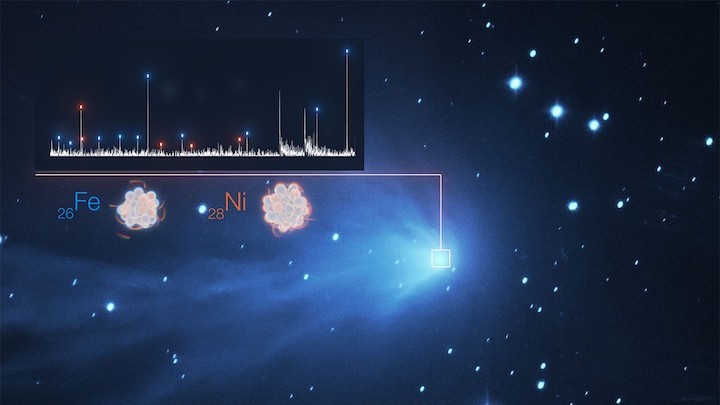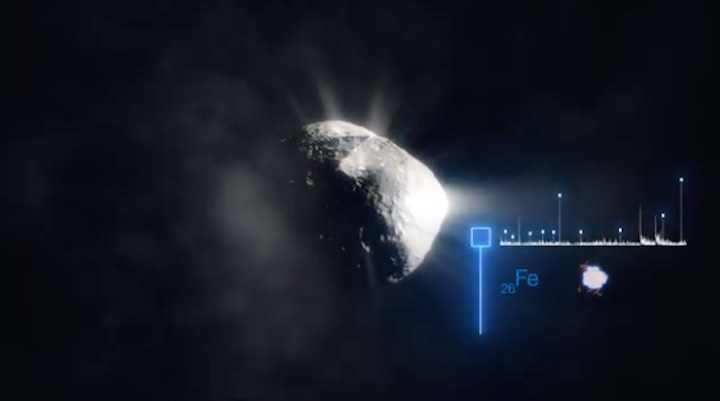21.05.2021

A study conducted by researchers from the STAR research unit (Faculty of Science) of the ULiège University reveals the surprising chemical composition - namely traces of free iron and nickel atoms - of comets atmospheres, even at great distances from the Sun. This important discovery, published in the scientific journal Nature, could provide new information on the formation of comets and the birth of our solar system.
A
new study by a team of astrophysicists from the University of Liège using data from the European Southern Observatory's (ESO) Very Large Telescope (VLT) shows the presence of iron and nickel in the atmosphere of comets, even those far from the Sun. This is the first time that heavy metals, usually associated with very hot environments, have been discovered in the cold atmosphere of comets. "It was a big surprise to detect iron and nickel atoms in all the comets we have observed over the last two decades, about 20 of them, and even in those far from the Sun, in the cold space environment," explains Jean Manfroid, scientific collaborator at the University of Liège and first author of the study.
Astronomers know that metals are present in the dusty, rocky interiors of comets. But since metals in solid form do not usually 'sublimate' (become gaseous) at low temperatures, they did not expect to find them in the atmospheres of comets far from the Sun. Nickel and iron vapours have even been detected in comets observed more than 500 million kilometres from the Sun, more than three times the distance from the Earth to the Sun.
"Comets formed about 4.6 billion years ago, in the very young solar system, and have undergone almost no transformation since then. In this sense, they are like fossils for astronomers and provide information on the first stages of the solar system, before the formation of planets", explains Emmanuel Jehin, FNRS Senior Research Associate in the STAR research unit (Faculty of Science) at ULiège and co-author of the study.
While the optical spectra of comets have been studied for decades, no one has ever detected the presence of nickel and iron in their atmospheres. "A discovery that went under the radar for many years! "says Emmanuel Jehin. This discovery is surprising because, prior to this study, heavy metals had only been observed in a gaseous state in very hot environments, for example in the atmosphere of ultra-hot exoplanets or very rare comets eroded by a passage too close to the Sun.
The team used the UVES (Ultraviolet and Visual Echelle Spectrograph) instrument on ESO's VLT, which uses the technique of spectroscopy, to analyse the atmospheres of comets at different distances from the Sun. This technique allows astronomers to reveal the chemical makeup of celestial objects: each element leaves a unique signature - a set of lines - in the spectrum of the light of the objects studied.

https://www.uliege.be/cms/c_13912427/en/unexpected-discovery-of-heavy-metal-vapours-in-solar-system-s-comets
Artist’s animation of the heavy metal composition of a cometary atmosphere
The Liège team was able to identify iron and nickel among the forest of lines appearing on the UVES spectra. A very small quantity of metals is emitted; the researchers estimate that for every 100 kg of water, there is only 1 g of iron and about the same quantity of nickel.
"Usually there is 10 times more iron than nickel in solar system objects, but in the atmosphere of these comets we found about the same amount of both elements. We concluded that they must come from a particular type of material on the surface of comet nuclei, sublimating at a fairly low temperature and releasing iron and nickel in roughly the same proportions," explains Damien Hutsemékers, astrophysicist and FNRS Research Director at ULiège, who took part in the study.
Although the team is not sure yet of the nature of this material, advances in instrumental astronomy - such as the Mid-infrared ELT Imager and Spectrograph (METIS) on ESO's future Extremely Large Telescope (ELT) - should allow researchers to confirm the source of the iron and nickel atoms in the atmosphere of these comets.
The team of ULiège scientists hopes that this discovery will pave the way for future research. "Now others will look for these lines and those of other metals in their archival data obtained with other telescopes," says Emmanuel Jehin. "We believe that this will also trigger new theoretical and laboratory studies on the subject.
Illustration
Detection of heavy metals in the atmosphere of comet C/2016 R2
The detection of the heavy metals iron (Fe) and nickel (Ni) in the fuzzy atmosphere of a comet are illustrated in this image, which features the UVES spectrum of light of C/2016 R2 (PANSTARRS) on the top left superimposed to a real image of the comet taken with one of the SPECULOOS telescopes at ESO’s Paranal Observatory. Each set of peaks in the spectrum represents a different element, with those for iron and nickel indicated by blue and orange dashes, respectively. Spectra like these are possible thanks to the UVES instrument on ESO’s VLT, a high-resolution spectrograph that spreads the light so much that individual peaks can be individually identified. In addition, UVES remains sensitive down to wavelengths around 300nm, a region where most of the important iron and nickel lines appear, meaning that the capabilities of UVES were essential in making this discovery.
Credit: ESO/L. Calçada, SPECULOOS Team/E. Jehin, Manfroid et al.
Quelle: UNIVERSITY OF LIÈGE
+++
Heavy metal vapours unexpectedly found in comets throughout our Solar System — and beyond
19 May 2021
A new study by a Belgian team using data from the European Southern Observatory’s Very Large Telescope (ESO’s VLT) has shown that iron and nickel exist in the atmospheres of comets throughout our Solar System, even those far from the Sun. A separate study by a Polish team, who also used ESO data, reported that nickel vapour is also present in the icy interstellar comet 2I/Borisov. This is the first time heavy metals, usually associated with hot environments, have been found in the cold atmospheres of distant comets.
“It was a big surprise to detect iron and nickel atoms in the atmosphere of all the comets we have observed in the last two decades, about 20 of them, and even in ones far from the Sun in the cold space environment," says Jean Manfroid from the University of Liège, Belgium, who lead the new study on Solar System comets published today in Nature.
Astronomers know that heavy metals exist in comets’ dusty and rocky interiors. But, because solid metals don’t usually “sublimate” (become gaseous) at low temperatures, they did not expect to find them in the atmospheres of cold comets that travel far from the Sun. Nickel and iron vapours have now even been detected in comets observed at more than 480 million kilometres from the Sun, more than three times the Earth-Sun distance.
The Belgian team found iron and nickel in comets’ atmospheres in approximately equal amounts. Material in our Solar System, for example that found in the Sun and in meteorites, usually contains about ten times more iron than nickel. This new result therefore has implications for astronomers’ understanding of the early Solar System, though the team is still decoding what these are.
“Comets formed around 4.6 billion years ago, in the very young Solar System, and haven’t changed since that time. In that sense, they’re like fossils for astronomers,” says study co-author Emmanuel Jehin, also from the University of Liège.
While the Belgian team has been studying these “fossil” objects with ESO’s VLT for nearly 20 years, they had not spotted the presence of nickel and iron in their atmospheres until now. “This discovery went under the radar for many years,” Jehin says.
The team used data from the Ultraviolet and Visual Echelle Spectrograph (UVES) instrument on ESO’s VLT, which uses a technique called spectroscopy, to analyse the atmospheres of comets at different distances from the Sun. This technique allows astronomers to reveal the chemical makeup of cosmic objects: each chemical element leaves a unique signature — a set of lines — in the spectrum of the light from the objects.
The Belgian team had spotted weak, unidentified spectral lines in their UVES data and on closer inspection noticed that they were signalling the presence of neutral atoms of iron and nickel. A reason why the heavy elements were difficult to identify is that they exist in very small amounts: the team estimates that for each 100 kg of water in the comets’ atmospheres there is only 1 g of iron, and about the same amount of nickel.
“Usually there is 10 times more iron than nickel, and in those comet atmospheres we found about the same quantity for both elements. We came to the conclusion they might come from a special kind of material on the surface of the comet nucleus, sublimating at a rather low temperature and releasing iron and nickel in about the same proportions,” explains Damien Hutsemékers, also a member of the Belgian team from the University of Liège.
Although the team aren’t sure yet what material this might be, advances in astronomy — such as the Mid-infrared ELT Imager and Spectrograph (METIS) on ESO’s upcoming Extremely Large Telescope (ELT) — will allow researchers to confirm the source of the iron and nickel atoms found in the atmospheres of these comets.
The Belgian team hope their study will pave the way for future research. “Now people will search for those lines in their archival data from other telescopes,” Jehin says. “We think this will also trigger new work on the subject.”
Interstellar heavy metals
Another remarkable study published today in Nature shows that heavy metals are also present in the atmosphere of the interstellar comet 2I/Borisov. A team in Poland observed this object, the first alien comet to visit our Solar System, using the X-shooter spectrograph on ESO’s VLT when the comet flew by about a year and a half ago. They found that 2I/Borisov’s cold atmosphere contains gaseous nickel.
“At first we had a hard time believing that atomic nickel could really be present in 2I/Borisov that far from the Sun. It took numerous tests and checks before we could finally convince ourselves,” says study author Piotr Guzik from the Jagiellonian University in Poland. The finding is surprising because, before the two studies published today, gases with heavy metal atoms had only been observed in hot environments, such as in the atmospheres of ultra-hot exoplanets or evaporating comets that passed too close to the Sun. 2I/Borisov was observed when it was some 300 million kilometres away from the Sun, or about twice the Earth-Sun distance.
Studying interstellar bodies in detail is fundamental to science because they carry invaluable information about the alien planetary systems they originate from. “All of a sudden we understood that gaseous nickel is present in cometary atmospheres in other corners of the Galaxy,” says co-author Michał Drahus, also from the Jagiellonian University.
The Polish and Belgian studies show that 2I/Borisov and Solar System comets have even more in common than previously thought. “Now imagine that our Solar System's comets have their true analogues in other planetary systems — how cool is that?,” Drahus concludes.
More information
This research was presented in two papers to appear in Nature.
The team that carried out the study “Iron and nickel atoms in cometary atmospheres even far from the Sun“ (https://doi.org/10.1038/s41586-021-03435-0) is composed of J. Manfroid, D. Hutsemékers & E. Jehin (STAR Institute, University of Liège, Belgium).
The team that carried out the study “Gaseous atomic nickel in the coma of interstellar comet 2I/Borisov” (https://doi.org/10.1038/s41586-021-03485-4) is composed of Piotr Guzik and Michał Drahus (Astronomical Observatory, Jagiellonian University, Kraków, Poland).
Quelle: ESO
